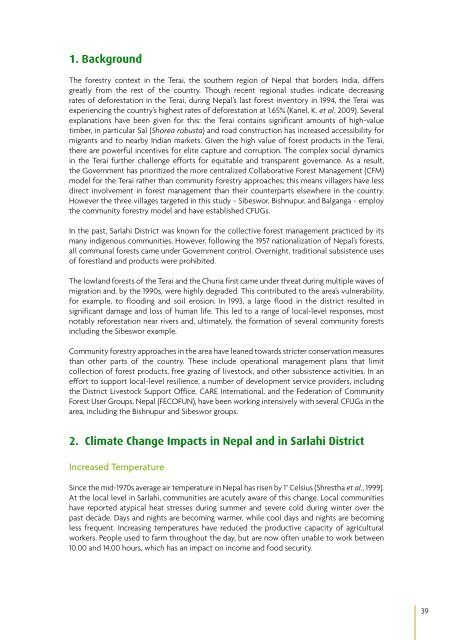Adaptation case studies.pdf - RECOFTC
Adaptation case studies.pdf - RECOFTC
Adaptation case studies.pdf - RECOFTC
You also want an ePaper? Increase the reach of your titles
YUMPU automatically turns print PDFs into web optimized ePapers that Google loves.
1. BackgroundThe forestry context in the Terai, the southern region of Nepal that borders India, differsgreatly from the rest of the country. Though recent regional <strong>studies</strong> indicate decreasingrates of deforestation in the Terai, during Nepal’s last forest inventory in 1994, the Terai wasexperiencing the country’s highest rates of deforestation at 1.65% (Kanel, K. et al, 2009). Severalexplanations have been given for this: the Terai contains significant amounts of high-valuetimber, in particular Sal (Shorea robusta) and road construction has increased accessibility formigrants and to nearby Indian markets. Given the high value of forest products in the Terai,there are powerful incentives for elite capture and corruption. The complex social dynamicsin the Terai further challenge efforts for equitable and transparent governance. As a result,the Government has prioritized the more centralized Collaborative Forest Management (CFM)model for the Terai rather than community forestry approaches; this means villagers have lessdirect involvement in forest management than their counterparts elsewhere in the country.However the three villages targeted in this study − Sibeswor, Bishnupur, and Balganga − employthe community forestry model and have established CFUGs.In the past, Sarlahi District was known for the collective forest management practiced by itsmany indigenous communities. However, following the 1957 nationalization of Nepal’s forests,all communal forests came under Government control. Overnight, traditional subsistence usesof forestland and products were prohibited.The lowland forests of the Terai and the Churia first came under threat during multiple waves ofmigration and, by the 1990s, were highly degraded. This contributed to the area’s vulnerability,for example, to flooding and soil erosion. In 1993, a large flood in the district resulted insignificant damage and loss of human life. This led to a range of local-level responses, mostnotably reforestation near rivers and, ultimately, the formation of several community forestsincluding the Sibeswor example.Community forestry approaches in the area have leaned towards stricter conservation measuresthan other parts of the country. These include operational management plans that limitcollection of forest products, free grazing of livestock, and other subsistence activities. In aneffort to support local-level resilience, a number of development service providers, includingthe District Livestock Support Office, CARE International, and the Federation of CommunityForest User Groups, Nepal (FECOFUN), have been working intensively with several CFUGs in thearea, including the Bishnupur and Sibeswor groups.2. Climate Change Impacts in Nepal and in Sarlahi DistrictIncreased TemperatureSince the mid-1970s average air temperature in Nepal has risen by 1° Celsius (Shrestha et al., 1999).At the local level in Sarlahi, communities are acutely aware of this change. Local communitieshave reported atypical heat stresses during summer and severe cold during winter over thepast decade. Days and nights are becoming warmer, while cool days and nights are becomingless frequent. Increasing temperatures have reduced the productive capacity of agriculturalworkers. People used to farm throughout the day, but are now often unable to work between10.00 and 14.00 hours, which has an impact on income and food security.39
















